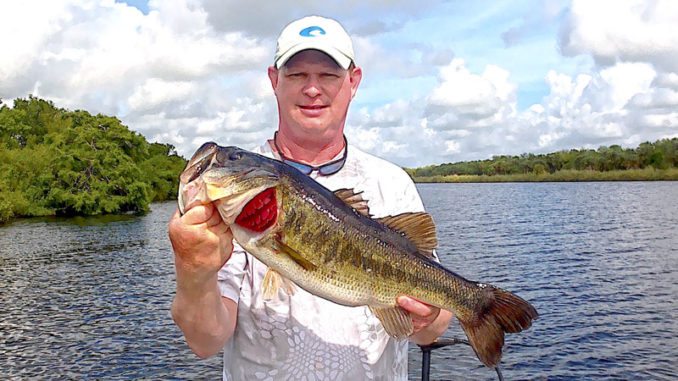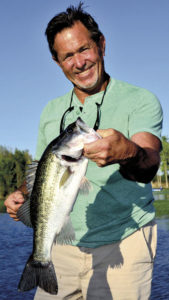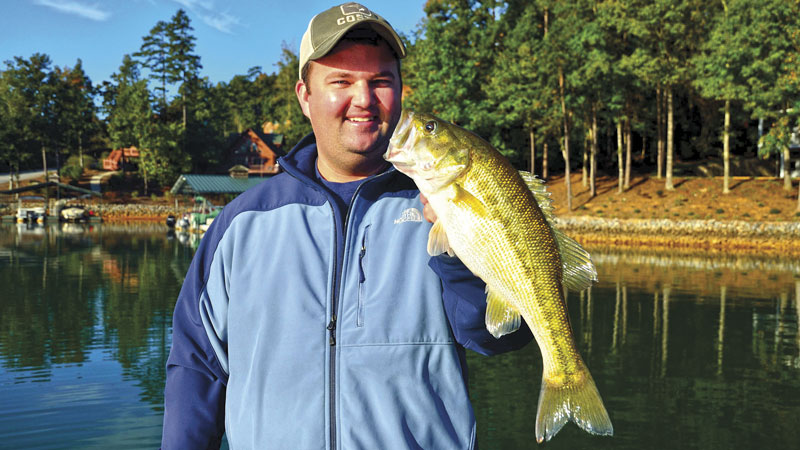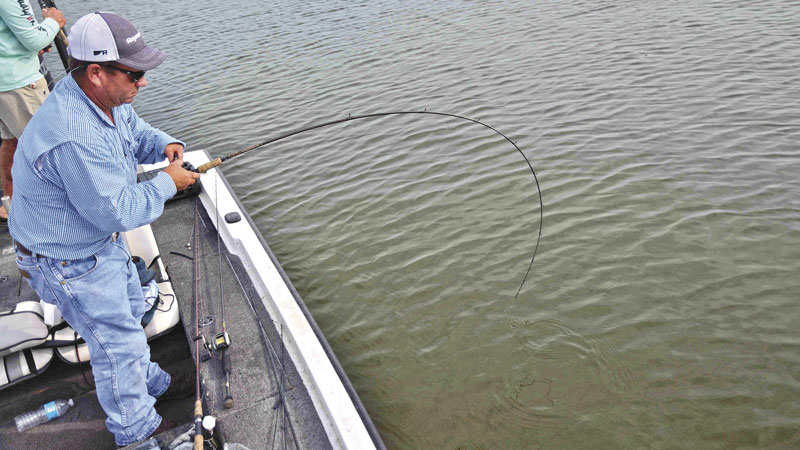
Fall and the lure of baitfish send bass on trip back into the shallows of lakes’ tributary creeks. Here’s how to find them and catch them.
It’s November, and fall is in full swing, with college football on the tube, big bucks on the move, and it’s an excellent time to fish at the coast and inland. While many anglers may choose to sit in a deer stand at dawn, there isn’t a better time to chase one of the South’s favorite finned targets: largemouth bass. Bass fishing in November can be off the chain in shallow water in many Carolina reservoirs.
Most bass anglers look forward to spring, when bass run into shallow water to spawn. During spawning season, bass are busy laying eggs and protecting their fry from predators. Without a doubt, the season can produce a good bite and lots of rod-bending action.
The fall shifts bass into the shallows as an area of similar real estate, but with an entirely different reasoning for travel — their appetite being the major cause.

Bass pro Jamie Pierce from Hallsboro, N.C., knows fall action on bass can be fantastic in shallow water.
“Bass move shallow in the fall and gorge on shad and other baitfish,” Pierce said. “The fish really fatten up in preparation for the colder months on the way.”
The critters inhabiting lakes and rivers undergo major lifestyle shifts in response to changes in the seasons and environmental conditions. When it comes to bass, the fall shift can be super productive in the right territory, and the right territory is the shallow regions of the lake.
“The water flips this time of year; that causes the shad and the bass to move higher in water column and into areas with better oxygen,” he said.
The water flip, aka turnover, is when the waters near the surface cool, the cooler, heavier water sinks and dissolves the summer thermocline. Poorly oxygenated water disperses, and lake life looks for better-oxygenated water near the surface, or better, in the shallow coves where highly oxygenated water is present. Additionally, shallow coves will have warmer water due to being protected from the wind, and they get more direct sunlight. The baitfish will move shallow first, and the predators will follow.
“I head to the backs of the coves in the fall. On reservoirs with lots of fingers, I go into the backs of these fingers and stay in water less than 8 feet deep,” he said.
Pierce heads back into coves and shallow places looking for visual evidence of bait on the surface and on his depth finder. If bait is present, bass will be there feeding.
In the fall, lure selection is less important than in other seasons. Bass surround schools of bait and attack, getting as many fish dinners in their mouths they can stand.
“Fish are quick to react on fast-moving and noisy lures that resemble shad or injured shad. Reaction baits are my first choice for fall fishing,” Pierce said.

Pierce will use topwater lures, jerkbaits, lipped and lipless crankbaits, spinnerbaits and any other lures that will quickly grab a fish’s attention.
“If you like to use reaction-type baits, the fall is by far the best time of year,” he said. “Not only do these baits work well, you can catch big numbers of fish, too, because these fish are feeding in schools.”
The weather can play a vital role in fall fishing success, but is it the actual rain, wind, cloud cover or sunshine, or is it something else?
Tournament fishing takes Pierce to the water in all weather conditions. Pierce recognizes certain weather patterns that produce better catches than others.
“We get a lot of cold fronts in the fall, and some of the best action is during the worst weather days, when it’s rainy and cold. But it’s also when the pressure is at its lowest. The low-pressure days are the best for bass fishing in the fall,” he said.
Approaching fronts impact the barometric pressure. As fronts arrive, the pressure falls, and the fish bite better than after a front when the pressure is rising. Pierce prefers to fish when pressure is either falling or at its lowest.
“The temperature and wind don’t matter much as much as the pressure; the fish will feed unbelievably on days with falling pressure in the fall, he said.

Selecting the right rod
A few decades ago, a 6½-foot spinning or casting rod was a standard tool for bass fishermen. But there isn’t such a thing as a standard spinning or casting rod any more. Technological advancements in materials and field tests from professional anglers have enabled rod companies to produce the best equipment possible, to improve all aspects of fishing from casting to retrieving.
Rod manufacturing is driven by fishing technique, and in the bass-fishing world, the selections are as wide as the Mississippi River. Choosing the right rod can be daunting, but many rods built for the bass-fishing community have shortened the learning curve.
Pro angler Jamie Pierce has fished for bass from Florida’s St. Johns River to the St. Lawrence River along the Canadian border. Rod selection is vital in his preparation process; he makes sure he brings the right equipment for the right job.
“I like certain rods for certain tasks,” Pierce said. “My rods will have specialized characteristics from the length of the butt end, to the size of the eyelets, and the flexibility and power throughout the entire length of the blank.”
Over the years, Pierce has used, literally, a boat-load of rods from about every company on the planet that makes them. He’s currently using Douglas rods.
“(They) are lightweight, durable, and they have the exact rods that I want for a few of my specific techniques,” he said.
Pierce uses two rods in the company’s XMATRIX Series for most techniques he uses in most tournaments: a 7-foot, 8- to 12-pound class medium-action rod, and a 7-foot-2, medium-heavy rod with a fast tip.
“The 7-foot (rod) is my perfect topwater rod because it has good backbone, a fast-action tip, a shorter handle, and it’s just the right length. The short handle doesn’t hit you in the side, and you can control it better at 7 feet than a longer version. The fast action allows you to retain hooksets and provides a mechanism to work the topwater with finesse,” he said.
The 7-foot-2 rod is for fishing spinnerbaits and other lures that are heavier in dense cover.
“I need this second rod to still have the soft tip to make it land where I want to and the extra backbone to get him out of heavy cover,” he said.
High-quality rods provide anglers with improved ability with less fatigue because high-quality rods are made of lighter and stronger materials.




Be the first to comment